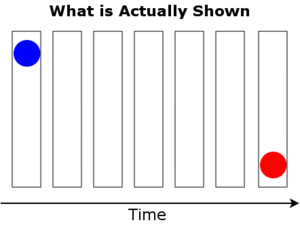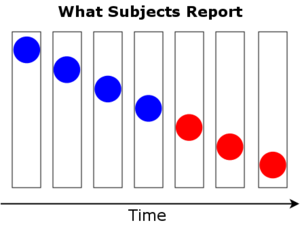Difference between revisions of "Color Phi phenomenon" - New World Encyclopedia
(started) |
({{Contracted}}) |
||
| Line 1: | Line 1: | ||
| − | {{Claimed}}{{Started}} | + | {{Claimed}}{{Started}}{{Contracted}} |
[[Category:Politics and social sciences]] | [[Category:Politics and social sciences]] | ||
[[Category:Psychology]] | [[Category:Psychology]] | ||
Revision as of 21:00, 7 September 2007
The Color Phi phenomenon is a perceptual illusion described by psychologists Paul Kolers and Michael von Grunau in which a disembodied perception of motion is produced by a succession of still images. The Color Phi phenomenon is a more complex variation of the Phi phenomenon.
The classic color phi phenomenon experiment involves a viewer or audience watching a screen, upon which the experimenter projects two images in succession. The first image depicts a blue dot at the top of the frame. The second image depicts a red dot on the bottom of the frame. The images may be shown quickly, in rapid succession, or each frame may be given several seconds of viewing time. Once both images have been projected, the experimenter asks the viewer or audience to describe what they saw.
At certain combinations of spacing and timing of the two images, a viewer will report a sensation of motion in the space between two dots. The first spot will begin appear moving, and will then "change color abruptly in the middle of its illusory path."
Philosophical Significance
The existence of the color phi phenomenon poses an interesting philosophical problem. When asked to describe their experience, subjects report the seeing the abrupt color change before the second dot is actually presented. However, logically, it is impossible for a subject to actually experience the color change before the second dot has been presented – how could the dot change color before the second dot is shown and the subject finds out what the color of the second dot is going to be?
Philosopher Daniel Dennett relies upon the color phi phenomenon in his argument against a philosophy known as Cartesian materialism.
External links
- An interactive demonstration of the color phi phenomenon.
ReferencesISBN links support NWE through referral fees
- Daniel C Dennett. (1991), Consciousness Explained, Little, Brown & Co. USA (ISBN 0-316-18065-3)
Credits
New World Encyclopedia writers and editors rewrote and completed the Wikipedia article in accordance with New World Encyclopedia standards. This article abides by terms of the Creative Commons CC-by-sa 3.0 License (CC-by-sa), which may be used and disseminated with proper attribution. Credit is due under the terms of this license that can reference both the New World Encyclopedia contributors and the selfless volunteer contributors of the Wikimedia Foundation. To cite this article click here for a list of acceptable citing formats.The history of earlier contributions by wikipedians is accessible to researchers here:
The history of this article since it was imported to New World Encyclopedia:
Note: Some restrictions may apply to use of individual images which are separately licensed.

